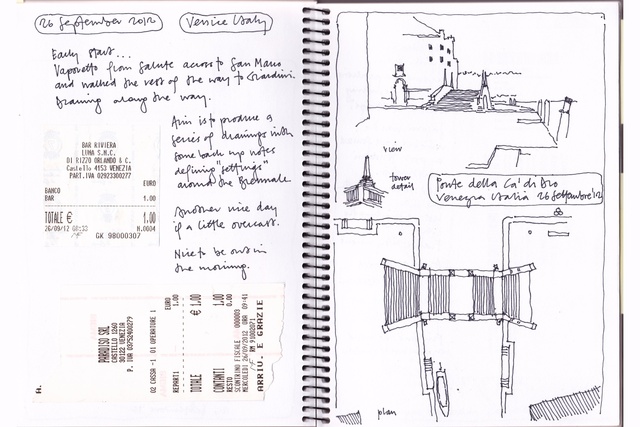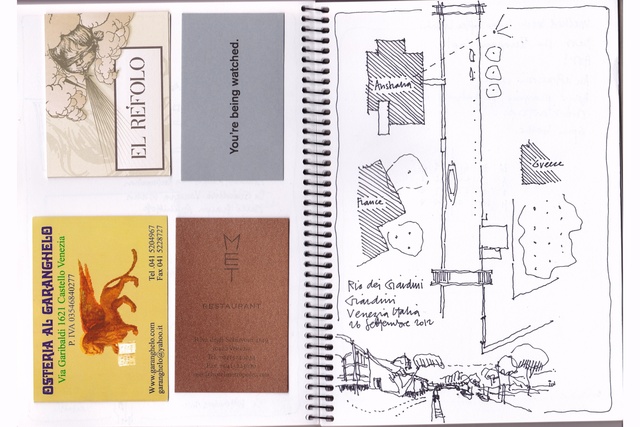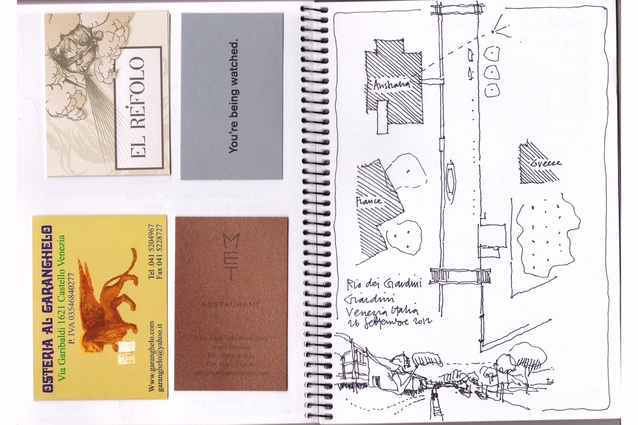Scenes from Venice
Illustrator and author of Drawing Paris and Drawing Italy, David Holm sends us sketchbook pages from his 2012 Venice trip.
Some of the sites that visitors to the Venice Architecture Biennale pass through daily – the Giardini, the Arsenale and the Castello district – have rich design-related histories that the casual visitor may not observe or appreciate, so I captured some of these little “venice settings” in a single day to hopefully prompt awareness of the depth of design that imbues Venice.

Ponte della Ca’ di Dio Venezia Italia
This bridge is one of a number that visitors to Venice experience on the journey from the centre of St Mark’s Square, along the water’s edge of the Riva – as it’s name changes from degli Schiavoni to di Ca’ di Dio, then finally to dei sette Martiri – before arriving at the Giardini site. On his grand tour, the celebrated artist William Turner (1775–1851) drew this bridge as part of his 1819 work Looking along the Schiavoni, with Bridge on Right, near Parochia de S. Giovanni in Bragora Ponte della Ca’ di Dio, in his sketchbook Venice to Ancona. Today the handsome stone-clad structure affords a vantage of the lagoon and is a pause point along the journey to the biennale.

Via Giuseppe Garibaldi Castello Venezia
Via Giuseppe Garibaldi is the main street that organizes the district of Castello. The area of Castello is the largest of the six districts, or sestieri, of Venice, and evolved in the thirteenth century around the original Venetian naval dockyard. The district around the Arsenale, to the north, eventually became the largest naval complex in Europe. It was later altered by Napoleon, who planned what are now the Bienniale Gardens to the south. Today via Giuseppe Garibaldi is the focus of a very traditional and historic part of Venice.

Monument to the Italian Participation la Giardini Venezia Italia
This is the monument to partisan women of the Italian Republic movement. It is located within the waters of the Venetian lagoon just outside the entrance to the Giardini. The original sculpture was designed by Italian Augusto Murer (1922–85) in 1961. It is a work in bronze, in which the artist depicted the body of a partisan lying on the ground. Celebrated Venetian architect Carlo Scarpa (1906–78) created the base. He imagined that the most correct and natural way to observe Murer’s sculpture was to position it in a lowest point of the observer, within the influence of the tidal waters.
Scarpa had originally conceived of making the sculpture float with the tide. However, this proved problematic against the currently fixed solution. Scarpa’s design work is also found within the Giardini in the Venezualan pavilion and the Central Pavilion.

Rio dei Giardini Venezia Italia
The Rio dei Giardini traditionally separates the two areas within the Giardini of San Giuseppe and San Elena. It has for many years been seen as a service canal connecting the northern reaches of the Arsenale to the lagoon. In the twentieth century, however, the Rio has become the address for a number of permanent country pavilions at the Venice Biennale. These include the pavilions of Greece, Austria and Brazil – and Australia’s (sadly) soon to be demolished pavilion. The robust masonry structure of the canal still serves as a utilitarian entry into the Giardini site and a reminder of the maritime manner of daily life.













